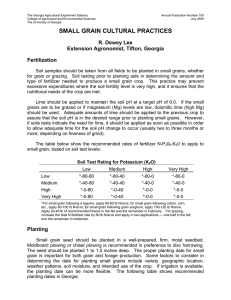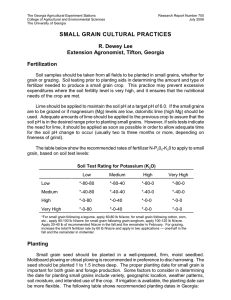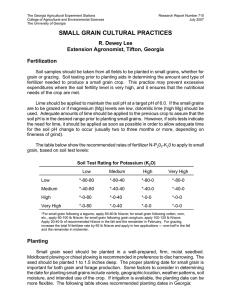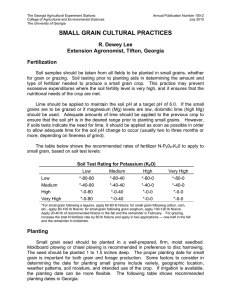The Georgia Agricultural Experiment Stations Research Report Number 715
advertisement
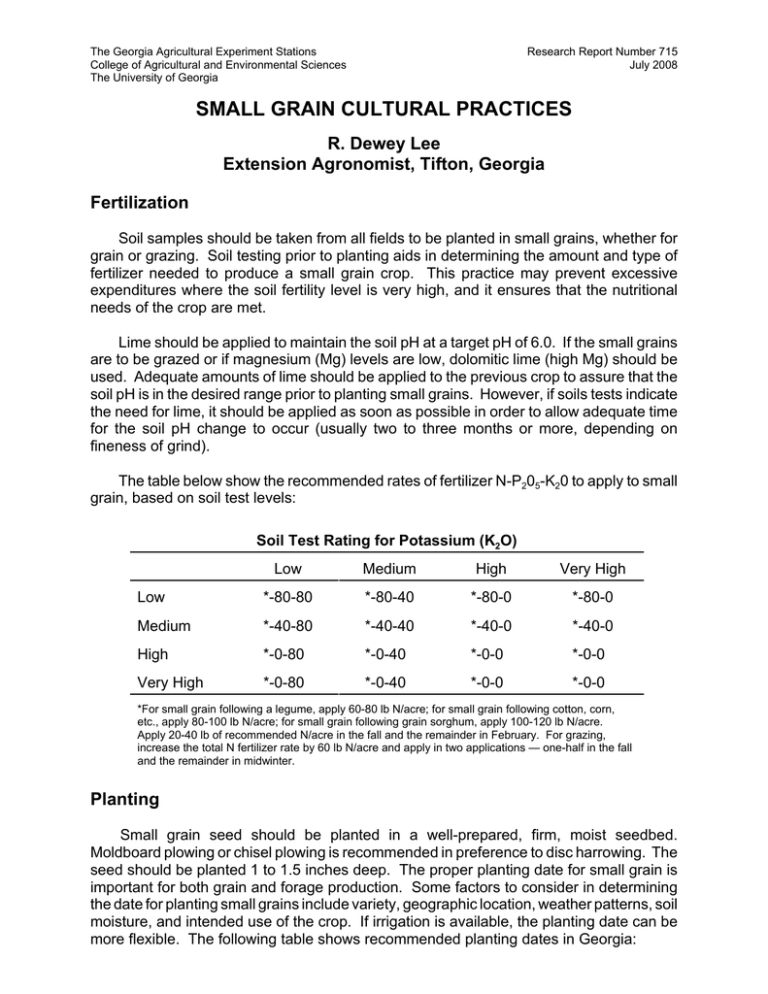
The Georgia Agricultural Experiment Stations College of Agricultural and Environmental Sciences The University of Georgia Research Report Number 715 July 2008 SMALL GRAIN CULTURAL PRACTICES R. Dewey Lee Extension Agronomist, Tifton, Georgia Fertilization Soil samples should be taken from all fields to be planted in small grains, whether for grain or grazing. Soil testing prior to planting aids in determining the amount and type of fertilizer needed to produce a small grain crop. This practice may prevent excessive expenditures where the soil fertility level is very high, and it ensures that the nutritional needs of the crop are met. Lime should be applied to maintain the soil pH at a target pH of 6.0. If the small grains are to be grazed or if magnesium (Mg) levels are low, dolomitic lime (high Mg) should be used. Adequate amounts of lime should be applied to the previous crop to assure that the soil pH is in the desired range prior to planting small grains. However, if soils tests indicate the need for lime, it should be applied as soon as possible in order to allow adequate time for the soil pH change to occur (usually two to three months or more, depending on fineness of grind). The table below show the recommended rates of fertilizer N-P205-K20 to apply to small grain, based on soil test levels: Soil Test Rating for Potassium (K2O) Low Medium High Very High Low *-80-80 *-80-40 *-80-0 *-80-0 Medium *-40-80 *-40-40 *-40-0 *-40-0 High *-0-80 *-0-40 *-0-0 *-0-0 Very High *-0-80 *-0-40 *-0-0 *-0-0 *For small grain following a legume, apply 60-80 lb N/acre; for small grain following cotton, corn, etc., apply 80-100 lb N/acre; for small grain following grain sorghum, apply 100-120 lb N/acre. Apply 20-40 lb of recommended N/acre in the fall and the remainder in February. For grazing, increase the total N fertilizer rate by 60 lb N/acre and apply in two applications — one-half in the fall and the remainder in midwinter. Planting Small grain seed should be planted in a well-prepared, firm, moist seedbed. Moldboard plowing or chisel plowing is recommended in preference to disc harrowing. The seed should be planted 1 to 1.5 inches deep. The proper planting date for small grain is important for both grain and forage production. Some factors to consider in determining the date for planting small grains include variety, geographic location, weather patterns, soil moisture, and intended use of the crop. If irrigation is available, the planting date can be more flexible. The following table shows recommended planting dates in Georgia: Recommended Planting Dates Coastal Plain Crop Piedmont Limestone Valley Grain Grazing Grain Grazing Grain Grazing 11/07*- 10/15 10/25 - 11/15 10/01 10/10 - 11/01 9/15 Oat 11/07 - 12/01 10/01 10/07 - 10/30 9/15 9/25 - 10/15 9/01 Barley 11/07 - 12/01 10/15 10/25 - 11/15 10/01 10/01 - 11/01 9/01 Triticale 11/15 - 12/15 - Rye 11/07 - 12/01 10/15 Wheat - - 10/07 - 11/15 10/01 - - 10/01 - 10/20 9/01 *November 7 in the Upper Coastal Plain and November 15 in the Lower Coastal Plain. Pest Control Check with your county extension agent for the latest information on weed, disease, and insect control in small grains. Varieties Select high-yielding, insect- and disease-resistant varieties for best results. In selecting varieties, give careful consideration to the statistics (LSD) reported in the tables. An explanation of their proper use is given in the preface to this report. The variety listed at the top of the list may be only one of the best. For late planting, the early-maturing varieties usually perform the best. Varieties recommended for the 2008 planting season are presented in the following tables. Recommended Grain Varieties for 2008 Barley Nomini (S) Price (S) Thoroughbred (S) Oat Horizpn 201 (S) Horizon 270 (S) Horizon 321 (S) Horizon 474 (C, P) Plot Spike LA9339 (S) Rodgers (P,M)2 SS76-40 (P,M) TAMO 405 (C) TAMO 406 (C) Wheat AGS 2000 (S)2 AGS 2010 (C) AGS 2020 (S)4 AGS 2026 (S) AGS 2031 (S)4 AGS 2060 (S)3 Coker 9553 (S)2,4 Dominion (P,M)4 Fleming (C)3 McIntosh (P,M) Oglethorpe (S) Pioneer 26R61 (S) SS 8641 (S) USG 3209 (S)4 USG 3295 (S)4 USG 3592 (P,M)2 1. M = Mountains; P = Piedmont; C = Coastal Plain; UC = Upper Coastal Plain; LC = Lower Coastal Plain; S = Statewide. 2. Consider using a fungicide; highly susceptible to powdery mildew, leaf rust, stripe rust or crown rust. 3. Plant at end of recommended planting period or later. 4. Susceptible to some Hessian fly; consider using an insecticide. Recommended Forage Varieties for 2008 Oat Horizon 321 (S) Horizon 474 (S) Horizon 270 (S) NK-Coker 227 (S) Rodgers (P,M) SS76-40 (C) Rye AGS104 (S) Bates (S) Early Graze (S) Oklon (S) Wintergrazer 70 (S) Wrens Abruzzi (S) Wrens 96 (S) Wheat AGS 2000 (S) Pioneer 26R61 (S) Roberts (P,M) USG 3209 (P, M) USG 3592 (S) 1. M = Mountains; P = Piedmont; C = Coastal Plain; UC = Upper Coastal Plain; LC = Lower Coastal Plain; S = Statewide. To ensure good germination, the absence of noxious weeds, and varietal purity plant certified, treated seed. General seeding rate recommendations based on bushels per acre are provided in Table 1. Seed size varies greatly from year to year and among varieties and seed lots. Therefore, more accurate plant populations may be achieved by using seeding rates based on seeds per area rather than on bushels per acre. For example, research on wheat has shown that seeding rates of 30-35 seeds per square foot are best for top yields. Accurate target populations are best achieved by adjusting grain drill settings based on number of seed per foot of row. Grain drill calibrations can be accomplished quickly and accurately by counting seed collected from one or more rows during travel over a specified distance and calculating the drill output as seeds per foot of row. Table 2 is provided as a guide to establish target populations of the small grain crops for popular row spacings. The figures in Table 2 are broadly based on the average number of seeds per pound for the various crops but even more accurate calibrations can be accomplished if the actual number of seeds per pound is known for the seed lot being planted. At least one seed supplier in the Southeast now prints seed size information on the bag. If seed size is known, Table 3 may more accurately predict seed requirements. Table 1. Recommended Seeding Rates for 2008 Crop Weight lb/bu Grain Grazing -------- bu/acre -------- Wheat 60 1.75-2.5 2.0-2.5 Oat 32 2.0 4.0 Barley 48 2.0-2.5 ----- Rye 56 1.0-1.5 2.0-2.5 Triticale 48 1.5-2.0 2.0-2.5 Table 2. Example of seeding rate of different small grains. Row Width (inches) Crop Seeding Rate 1 6 1 7 8 10 seeds/sq.ft. lb/A Barley 19 25 32 72 96 120 1.5 2.0 2.5 10 13 16 11 15 19 13 17 21 16 21 27 Oat 19 24 28 38 64 80 96 128 2.0 2.5 3.0 4.0 10 12 14 19 11 14 16 22 13 16 19 25 16 20 23 32 Wheat 27 37 47 55 90 120 150 180 1.5 2.0 2.5 3.0 14 18 24 28 16 22 27 32 18 25 31 37 23 31 39 46 Rye 31 46 62 56 84 112 1.0 1.5 2.0 16 23 31 18 27 36 21 31 41 26 38 52 bu/A -------- seed per foot of row -------- 1. Estimates based on average seeds per pound of 11,500 for barley, 12,875 for oat, 13,250 for wheat, and 24,000 for rye. Data compiled by J. L. Day, Griffin Campus, Griffin, Georgia. Table 3. Seeding rates for wheat based on seed size1. Desired Population (seeds per square foot) 30 32 34 35 36 38 40 Seed Size Seeding Rate seeds/lb ----------------------------------- lb/A ----------------------------------- 10,000 11,000 12,000 13,000 14,000 15,000 16,000 17,000 18,000 145 132 121 112 104 97 91 85 81 155 141 129 119 111 103 97 91 86 165 150 137 127 118 110 103 97 91 1. Seeding rate assumes 90% germination. 169 154 141 130 121 113 106 100 94 174 158 145 134 124 116 109 102 97 184 167 153 141 131 123 115 108 102 194 176 161 149 138 129 121 114 108
